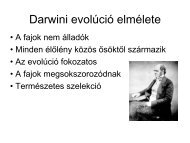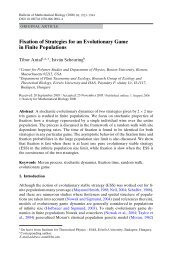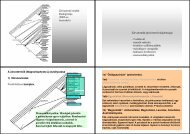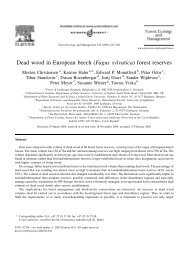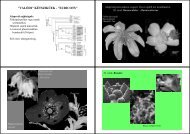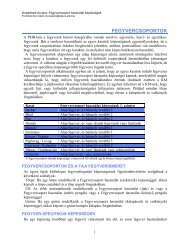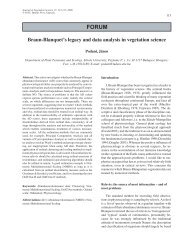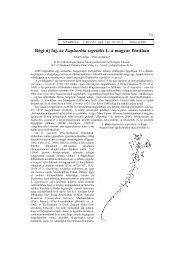Substitution modelsOur aim was to build a software package for an insertion-deletion model that can be coupled <strong>with</strong> anarbitrary substitution model. Therefore we would like to give users the option to implement their ownsubstitution models. In the software help file, we describe how users can extend this class to create theirown substitution models. We currently provide a large selection of eight nucleotide substitution modelsincluding the Jukes-Cantor model [45], the Kimura three parameter model [46], <strong>and</strong> the HKY85 model [47].PostprocessingOur program provides r<strong>and</strong>om samples from a Markov chain whose stationary distribution is the joint<strong>Bayesian</strong> distribution of sequence alignments, locations of fast <strong>and</strong> slow regions, <strong>and</strong> model parameters.This high dimensional joint distribution can be analyzed in several ways, ranging from an analysis of theposterior distribution of a single rate parameter to an investigation of Markov chain convergence usinga log-likelihood trace or a separate multidimensional autocorrelation analysis. We implemented a set ofpostprocess plugins which analyze data from the Markov chain <strong>and</strong> display in the graphical interface. In thesoftware help file, we also describe how the user can implement their own postprocess plugin by extendingthe abstract class.We implemented the following plugins, each of which represents a tab in the graphical interface:• Log-likelihood trace This plugin plots the log-likelihood trace <strong>and</strong> writes the log-likelihood valuesinto a text file when the analysis is complete.• Current alignment This plugin shows the multiple sequence alignment in the current state of theMarkov chain, along <strong>with</strong> the locations of slow <strong>and</strong> fast regions. Capital letters in the alignmentrepresent slowly evolving regions in the current state of the chain, while lower case letters representquickly evolving regions.• MPD alignment This plugin calculates <strong>and</strong> performs running updates of the Maximum PosteriorDecoding alignment based on all previous samples of the Markov chain. Fig. 4 pictures this alignmentdisplay, along <strong>with</strong> two curves overlaying the sequence information. The blue curve represents theposterior probability of each alignment column: higher values indicate greater confidence in the alignment.The red curve represents the phylogenetic footprinting results: higher values indicate a greaterposterior probability of purifying selection. The final MPD alignment, <strong>and</strong> all footprinting results, arewritten into a text file after the analysis is complete.• Current tree This plugin graphically displays the tree inputted by the user.Computational powerWe initially assessed convergence using a log-likelihood trace, <strong>and</strong> verified convergence using independentMCMC runs. We found that 10 6 -10 7 steps were required for convergence, depending on the number ofsequences <strong>and</strong> their lengths. To remove the effects of autocorrelated samples, we took a sample of the chainafter every 5000 iterations of the MCMC. For all examples, total computational time did not exceed 16 hourson a 2ghz Macbook computer. Datasets larger than 12 species can also be analyzed, but may take longer toachieve convergence.MethodsThe <strong>Alignment</strong> TransducerOur model is powered by an evolutionary transducer describing the evolution between the ancestor <strong>and</strong>the descendent on each branch of the phylogenetic tree. The transducer models the evolutionary historyof insertions <strong>and</strong> deletions in order to infer a DNA sequence alignment, but also identifies slowly evolving8
egions represented by three slow states (colored in blue). As described previously, evolutionary time isscaled down in slow states to represent the effects of purifying selection.An HMM transducer is similar to a pairwise HMM. However, all transitions <strong>and</strong> emissions in a transducerare normalized conditional on the input (ancestral) sequence. Transitions to a slow state only occur whenthere is a “slow” character emitted in the ancestral sequence, <strong>and</strong> the same is true of fast states <strong>and</strong> fastcharacters. The model switches between fast <strong>and</strong> slow states only when a character type switch is emittedfrom the ancestral root. As previously discussed, the ancestral root node switches between emitting fast <strong>and</strong>slow characters according to a basic hidden markov model.The transducer model contains two “wait” states, W1 <strong>and</strong> W2, to which the model transitions whilewaiting for input from the ancestral sequence. These transitions occur after the transducer has finishedprocessing the previous character from the ancestral sequence (for example, after the ancestral character hasbeen either matched or deleted in the descendent), <strong>and</strong> the transducer will remain in the wait state until theancestral sequence emits the next character. This allows the transducer to pause while other evolutionaryevents, such as indels on a different half of the tree, occur in other sequences. A second wait state is neededsince unlike the insertion state, the delete state cannot self-transition. This second wait state, which onlythe delete state can access, creates an effective self-transition that allows for the modeling of long deletionevents. The full transition matrix for our HMM transducer is shown in the Supplementary Material, <strong>and</strong>a complete explanation of wait states <strong>and</strong> the general application of HMM transducers to sequence alignmentcan be found in [29].MCMC Transition KernelsIn order to combine both alignment <strong>and</strong> phylogenetic footprinting, we needed to introduce new samplingmoves for our r<strong>and</strong>om walk. At each state in the chain, we kept track of the points where the HMM transducerswitched between fast <strong>and</strong> slow states, corresponding to a predictive switch between neutral sequences <strong>and</strong>functional elements. For display purposes (see Fig. 6), we capitalized nucleotides emitted from slow statesin the sequence alignment at each step. We found that only three new types of moves were necessary toprovide good mixing.• Shifting location of existing boundaries. We extend (or shrink) an existing boundary <strong>and</strong> calculatethe effect on the overall likelihood. We fix the root sequence <strong>and</strong> switch a small number ofnucleotides (determined by a geometric distribution) in the root between fast <strong>and</strong> slow. Fig. 6 displaysa boundary shift of three nucleotides. This move is especially helpful for accurately calculatingfootprinting posterior probabilities near the ends of functional regions.• Creating a new pair of boundaries. This move proposes either a new slowly evolving region in astretch of neutral sequence (see Fig. 7), or a new neutral region in the middle of a conserved element,creating two separate binding sites. The lengths of the new regions are proposed from simple stepwisedistributions. When proposing new conserved regions, we expect the lengths to span approximately5-10bp. We propose shorter lengths for new quickly evolving regions when splitting a conserved regionin two, as there are often short stretches of 1-4 degenerate nucleotides in a long conserved binding site.To achieve better mixing, we scan the existing alignment for areas where new boundaries may improvethe likelihood before proposing new regions. We calculate a very basic conservation score, based onthe number of mutations in the alignment column, <strong>and</strong> weight our proposals towards regions <strong>with</strong> highconservation (for new slowly evolving regions) or low conservation (for new quickly evolving regions).• Deleting an existing pair of boundaries This move is the exact reverse of the move describedabove, <strong>and</strong> is also pictured in Fig. 7. It corresponds to the merging of three heterogeneous regionsinto one homogeneous region. When proposing regions to merge, we weight our proposals towardsregions whose lengths differ significantly from the expected geometric distribution set by the HMM inthe ancestral root.9



